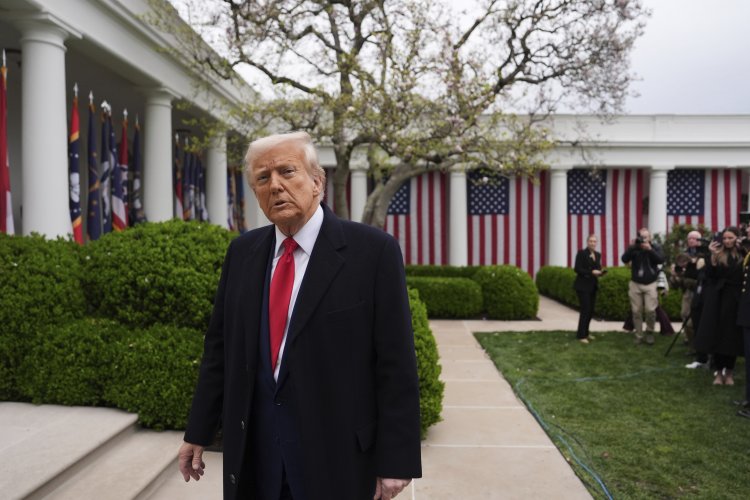Diplomats perceive ‘mess’ in Trump’s approach to trade
A PMG survey conducted across over 15 countries, featuring five major Asian trading partners, indicated uncertainty regarding the administration's strategy.

The administration has initiated an ambitious plan to hold discussions with over 70 countries within the next 90 days, all amid a volatile stock market and increasing public dissatisfaction.
So far, Trump has focused on a limited set of serious negotiations with Vietnam, India, South Korea, and Japan, favoring these strategic partners that are essential in contending with China, according to two sources close to the White House who requested anonymity to discuss these strategies. A White House official, speaking on the same condition, validated this approach.
Consequently, most countries find themselves in limbo, awaiting attention from the world's largest economy, during a time when they face the highest export rates to the U.S. in nearly a century. Although Trump temporarily halted some of his most significant tariffs earlier this week, the 10 percent tariff imposed on all countries on April 2 remains in effect, with indications from Trump that he is considering dismantling additional trade barriers.
A PMG survey involving more than 15 nations, including five key Asian trading partners, indicated confusion regarding the administration's tactics.
“We really don't know what the Trump administration wants,” an Asian diplomat close to the negotiations stated. Like others quoted, this official was granted anonymity to speak candidly about the sensitive issue.
“We’ve been told literally nothing,” said another official representing an Asian country. They suggested that the lack of clarity from the administration reflects a deal-making process that is “reactive, with no clear direction.”
The administration's initial focus on Asian nations with connections to China is part of its strategy to tackle what it describes as extensive illegal shipments that effectively launder Chinese goods through countries like Vietnam and Cambodia.
Embassy personnel from two key Asian trading partners reported that their teams were working to establish connections between their trade officials and the White House.
“I’d say my colleagues are trying to lay the groundwork” for discussions, remarked one of those diplomats.
The White House did not respond to inquiries regarding the current state of negotiations or whether the pause on tariffs would extend if no agreements are reached.
This approach creates uncertainty about the likelihood of reaching agreements with every country by Trump's self-imposed deadline for reinstating reciprocal tariffs. As a result, many nations face a 10 percent tariff that could hamper the global economy and strain countries dependent on exports to the U.S., even if they are eager to negotiate.
The U.S. has conveyed that Israel's decision to eliminate tariffs on U.S. goods was insufficient for an early agreement, despite a direct appeal from Israeli Prime Minister Benjamin Netanyahu to Trump. Additionally, the European Union's public proposal to eliminate all tariffs on vehicles and industrial goods with the U.S. was declined.
The administration’s strategy effectively places key trading partners—including the EU, China, Canada, and Mexico—in a waiting game for a deal, despite their significant combined trade with the U.S., totaling over $3.1 trillion.
"Every country is banging on the White House's door at once so it's no wonder they're not responding to everyone. But what did they expect with worldwide tariffs? It's a mess," commented an EU diplomat. EU leaders are now questioning whether "this is a dealmaking tactic or the start of a total paradigm shift in how the U.S. will view global trade. And that has us quite rattled,” he added.
The pressing nature of the tariffs has relegated embassy personnel to supporting roles as senior officials travel from foreign capitals for discussions. There is a pervasive sense of pessimism surrounding these negotiations.
“It doesn’t seem like the baseline 10 percent has room for adjustment so far,” one diplomat observed.
Asian diplomats observing from the sidelines have voiced confusion regarding the administration’s trade policy and the challenges faced in engaging in constructive conversations, particularly following Trump’s abrupt changes to the original so-called Liberation Day tariffs.
“It's going to take more than removing tariffs,” said Ken Weinstein, the Japan Chair at the Hudson Institute and a former U.S. ambassador designate to Japan during Trump’s first term. “It's going to also take removing non-tariff barriers as well, which are critical and investing. But the issue is, how far can people go to please the administration?”
The situation with South Korea’s trade envoy Cheong In-kyo illustrates the challenges faced.
Cheong met with U.S. Trade Representative Jamieson Greer to discuss the 25 percent tariff on imports from Seoul. The next day, Trump reduced that tariff to 10 percent for South Korea and other targeted countries, excluding China. Despite the confusion, Cheong reported returning home with “a framework for item-by-item negotiations, particularly concerning steel and automobiles,” according to the Korea Herald.
Another Asian diplomat noted that while their country is eager to engage the Trump administration about a deal, they do not expect to be prioritized due to being a smaller trading partner.
Nonetheless, several countries are claiming limited progress towards preventing the implementation of tariffs.
One Indian diplomat acknowledged differences in near-daily conversations between lower-level officials from both nations, expressing confidence that “gaps can be bridged” before tariffs resume.
Vietnam announced the commencement of formal talks regarding reciprocal tariffs on its government website, stating that “the two countries need to soon negotiate a bilateral trade agreement to create a long-term framework.”
Japan has expressed readiness to discuss non-tariff barriers. The country is sending Economic Revitalization Minister Akazawa Ryosei to Washington for direct discussions with Greer and Treasury Secretary Scott Bessent, with “non-tariff barriers and exchange rates” expected to be on the agenda.
However, any effort to address non-tariff barriers could complicate negotiations, according to trade experts. If the administration targets perceived barriers such as the value-added tax or digital services taxes, it would require those nations to effectively overhaul their tax structures to satisfy Trump’s demands.
Additionally, the administration has indicated its goal of reducing obstacles that hinder U.S. agricultural exports to countries like Australia, Israel, and the EU. These barriers can be particularly daunting given the political ramifications surrounding local farmers and environmental laws.
“Making that kind of concession is risky,” remarked William Reinsch, a former senior U.S. trade official and current advisor at the Center for Strategic and International Studies. “It’s very easy to demagogue: ‘Americans want us to have unsafe cars. They want us to have dirtier air. And they want us to have sick chickens. And they want us to drink bad wine.’”
Countries with smaller, less developed economies have limited flexibility in negotiations to eliminate both reciprocal and Trump’s flat 10 percent tariff on all imports, making it unrealistic for them to significantly address Trump’s concerns regarding the trade deficit in the near term.
One African diplomat noted that their government has opted to “lay low,” having been less affected by the original tariffs compared to other nations.
A diplomat from Latin America mentioned their country has made several requests for meetings with higher-level officials at the Commerce and Treasury departments but has yet to receive a response.
“We’re out from the worst of it,” the official stated, adding that they are still “weighing what to do.”
Ian Smith for TROIB News
Find more stories on Business, Economy and Finance in TROIB business












